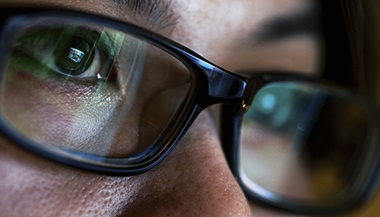How Sunglasses Help Protect Your Eyes' Health
Featured Expert
Summertime means a lot of sun exposure as we ramp up our time outdoors. Sunny days might prompt us to layer on sunscreen, wear a hat or consider covering up to avoid sunburn. With those precautions, sunglasses might seem like a secondary concern, helpful if you need clear vision on a bright day for driving or sports, but not essential.
However, sunglasses provide important protection from ultraviolet (UV) sunlight in the same way that sunscreen or covering up helps protect our skin. Bryce St. Clair, an optometrist at the Wilmer Eye Institute, Johns Hopkins Medicine, explains the danger of too much sun for your eyes, how sunglasses can help and what to look for when purchasing a pair.
How Sun Can Damage Your Eyes
Sun damage is caused by ultraviolet light rays from the sun. This UV light is not visible to humans, but it makes up a large chunk of the energy that the Earth receives from the sun every day. While our skin is more sensitive to UV light than our eyes, our eyelids are very sensitive to the light we receive from the sun.
Sun damage to the eyes includes:
- Basal or squamous carcinoma on the eyelids, caused by excessive sun exposure on the lids. These are common skin cancers that are rarely fatal, but they can be aggressive.
- Pterygium, or ”surfer’s eye,” is caused by too much UV light. Surfer’s eye is a cloudy, wedge-shaped bump that typically forms on the corneas (the outer layer of the eye), stretching from the corner toward the pupil at the center of your eye. Typically, these growths remain small, but they sometimes expand, affecting vision and causing discomfort.
- Photokeratitis (sunburned eyes). This condition is exactly what it sounds like — sun exposure literally burns the cornea and conjunctiva (the inside of your eyelids), causing eye sensitivity and pain, redness, watery eyes, blurry vision and swelling.
How Sunglasses Help Protect from UV Rays
The type of UV protection offered by sunglasses depends on the material of the lens. Polycarbonate lenses have built-in UV protection, but some glass and all plastic lenses need a special coating in order to block UV rays. This coating functions in a similar manner to sunscreen on the skin, providing a transparent layer that allows light to pass but blocks all or most of the UV rays from sunlight and surfaces from which sunlight reflects. Sunglasses with UV protection are usually marked as such, regardless of the lens material.
Picking the Right Pair of Sunglasses
Not all sunglasses prevent UV rays from reaching your eyes and causing the conditions described above. Here’s what to look for regarding sunglasses and UV radiation protection:
- Percent of UV protection: Look for sunglasses with 95%–100% UV protection or a “UV 400” sticker.
- Lens color: It does matter — brown, green and gray lenses are best. Yellow lenses provide less protection.
- Polarized lenses: These are helpful because they reduce glare and reflections, but they can be inconvenient if you need to use a device with a screen.
If you’re uncertain about how much UV protection your sunglasses offer, verify the UV protection with a photometer. Your eye-care doctor may have this device, and it is available for use at some sunglasses retailers.
Beyond the lenses themselves, consider practical concerns such as impact resistance, style and cost.
When should you wear sunglasses
Since some UV rays are present year-round, wearing sunglasses as much as possible is recommended. Even on a cloudy day, UV light is present, and it will reflect off a range of surfaces, including concrete, snow, sand and water. In winter weather conditions, can occur when UV light reflects off of snow. This condition is commonly known as “snow blindness.”
Wearing sunglasses as frequently as possible from a young age is key to minimizing UV damage to the eye and surrounding tissues.
Wearing Sunglasses Indoors
Blue light from screens may affect circadian rhythms, and excessive screen time has been shown to cause eye strain and dryness. However, there is no evidence that blue light is damaging to the eyes.
Blue-light sunglasses may address eye strain for those who have to be in front of a screen for extended periods for work or school, but there is currently little evidence that they can serve as a treatment for circadian rhythm problems.
For chronic migraine sufferers, FL-41 (light pink) sunglasses have been shown to help with fluorescent photosensitivity and reducing migraine episodes.
If you have any questions about sunglasses and eye health, your eye doctor can help.







